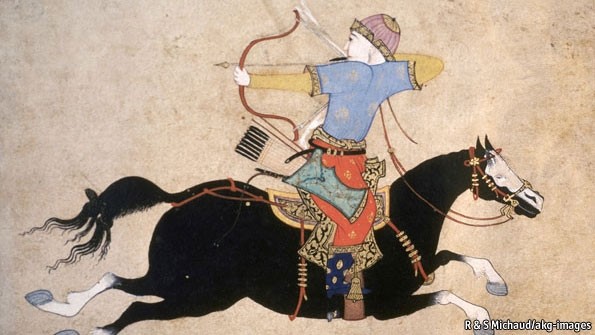

 字體:小 中 大
字體:小 中 大 |
|
|
|
| 2019/05/18 23:13:30瀏覽48|回應0|推薦0 | |
整理到2012年12月筆者所發的文章時,有一篇提到成吉思汗的西征與氣候的相關性,於Science & Technology專欄的雜誌編輯紙本版原文,貼在下方: The rise of Genghis KhanA horde of dataThe world’s greatest land empire was probably encouraged by climate changeDec 8th 2012 | San Francisco | from the print edition
IN THE second half of the 20th century, Mongolia warmed by 2°C—an increase few, if any, other countries can match. Recent change has brought droughts and zuds(winter storms) which complicate the lives of the country’s herders of sheep, cattle and goats as they adjust to a market economy after decades of communism. This year’s meeting of the American Geophysical Union, in San Francisco, however, heard of an earlier change in the Mongolian climate that may have been responsible for complicating the lives of rather more than just a few herdsmen. For if Amy Hessl of West Virginia University and Neil Pederson of Columbia University are correct, it was an alteration in the climate that allowed Genghis Khan and his horde to conquer half of Eurasia. The great Khan rose to power in 1206, the year he united Mongolia’s tribes behind him, and died in 1227. Dr Hessl and Dr Pederson have tree-ring data which seem to show that from 1208 to 1231 Mongolia enjoyed a string of wetter-than-usual years which was longer than any other such period in the past millennium. Previous tree-ring studies show the same period was also unusually warm. In this section · Mongolia A clement climate lasting a generation would have provided richer grazing than normal. More fodder means more horses, and thus more of the wherewithal of empire—for if an army marches on its stomach, a horde surely gallops on its grazing. No one thinks that the Great Khan himself had nothing to do with it. But his strategic genius might have been for naught if the climate had provided him only with broken-down nags. The next stage of the research, which also involves Nachin Baatarbileg of National University of Mongolia, will be to gather more samples. Tree-ring specialists like their trees old and stressed: old, because that gives insight into times for which no human records exist, and stressed because that exacerbates the climate’s effect on growth. The trees the team are studying, which scrape a living on a lava field north of Karakorum, Genghis’s capital, are both. The researchers also want to look at lake sediments. By counting spores from a fungus called Sporomiella, which grows in animal dung, they hope to find out whether there really was an animal-population boom at the time. They are also broadening their team, by recruiting a historian and an ecosystem modeller. And they would like to extend their records back to the first millennium AD. The Khanate was not the only empire to rise from the grasses of Mongolia. The researchers want to know how climate influenced the Göktürk and Uyghur empires in the sixth to ninth centuries. Historians and archaeologists have often argued that climate plays a role in the decline and fall of nations and empires, from the collapse of the eastern-Mediterranean bronze age, via the end of the Maya city-states of Central America, to the revolution that destroyed France’s ancien regime. To link it to the rise of an empire is more unusual, and raises fascinating questions about the degree to which history can be enriched by the study of things such as the supply of available energy. It is even possible that a better understanding of Mongolia’s past climate may help Genghis’s descendants as they try to cope with the striking changes of the present. from the print edition | Science and technology · Recommended · 7 · |
|
| ( 心情隨筆|心情日記 ) |










